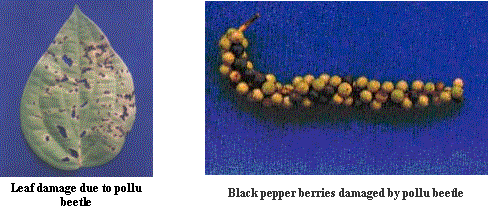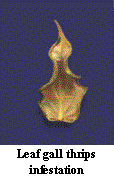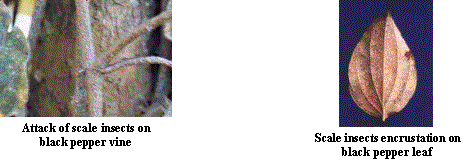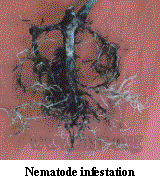|
Pests
Pollu Beetle
Occurrence and symptoms:
The pollu beetle (Longitarsus nigripennis) is the most destructive pest
of black pepper and is more serious in plains and at altitudes below 300m. The adult
is a small black beetle measuring about 2.5m x 1.5mm, the head and thorax being
yellowish brown and the forewings (elytra) black. Fully-grown grubs are creamy-white
and measure about 5mm in length.

The adult beetles feed and damage tender leaves and spikes. The females lay eggs
on tender spikes and berries. The grubs bore into and feed on the internal tissues
and the infested spikes turn black and decay. The infested berries also turn black
and crumble when pressed. The term pollu denotes the hollow nature of the infested
berries in Malayalam. The pest infestation is more serious in shaded areas in the
plantations. The pest population is higher during September-October in the field.
Management:
Regulation of shade in the plantation reduces the population of the pest in the
field. For the control of pollu caused by the flea beetle Longitarsus nigripennis,
spray any one of the following insecticides namely, dimethoate or quinalphos at
0.05% concentration. The spraying is to be given at the time of spike emergence
(June-July), at berry formation (September-October) and once again at berry maturing
stage, if needed. It can also be controlled by spraying cypermethrin 0.01% twice,
first at the berry formation stage and the second one-month after the first spray
(Sept-Oct.).
Leaf gall thrips
Occurrence and symptoms:
 Infestation by leaf gall
thrips (Liothrips karnyi) is more serious at higher altitudes especially
in younger vines and also in nurseries in the planes. The adults are black
and measure 2.5 – 3.0 mm in length. The larvae and pupae are creamy
white. The feeding activity of thrips on leaves causes the leaf margins to
curl downwards and inwards resulting in the formation of marginal leaf galls.
Later the infested leaves become crinkled and malformed. In severe cases of
infestation, the growth of younger vines and cuttings in the nursery is affected. Infestation by leaf gall
thrips (Liothrips karnyi) is more serious at higher altitudes especially
in younger vines and also in nurseries in the planes. The adults are black
and measure 2.5 – 3.0 mm in length. The larvae and pupae are creamy
white. The feeding activity of thrips on leaves causes the leaf margins to
curl downwards and inwards resulting in the formation of marginal leaf galls.
Later the infested leaves become crinkled and malformed. In severe cases of
infestation, the growth of younger vines and cuttings in the nursery is affected.
Management:
Spray dimethoate @ 0.05% during emergence of new flushes in young vines in the field
and cuttings in the nursery.
Scale insects
Occurrence and symptoms:

Among the various scale insects recorded on black pepper, mussel scale (Lepidosaphes
piperis) and coconut scale (Aspidiotus destructor) cause serious
damage to the vines at higher altitudes and also to older cuttings in nurseries
in the planes. Females of mussel scales are elongated (about 1mm length) and
dark brown and coconut scales circular (about 1mm diameter) and yellowish brown.
Scale insects are sedentary, remaining permanently fixed to plant parts and appear
as encrustations on stems, leaves and berries. They feed on plant sap and
cause yellowing and wilting of infested portions; in severe cases of infestations
the affected portions of vines dry up. The pest infestation is most severe
during post monsoon and summer periods.
Management:
Clip off and destroy severely infested branches. Two sprayings of dimethoate (0.05%
at fortnightly intervals after the harvest of berries effectively control black
pepper mussel scale). Initiate control measures during early stages of pest infestation.
In nurseries spraying neem oil 0.3% or Neemgold 0.3% or fish oil rosin 3.0% is also
effective in controlling the pest infestation.
Two sprays of Azadiractin 5000 ppm at 15 days interval after the incidence of scale insect.
Thiomethoxam 0.013% two sprays at an interval of 15 days after incidence of scale insect is also recommended.
Top shoot borer
Occurrence and symptoms:
The top shoot borer (Cydia hemidoxa) is a serious pest in younger plantations in
all black pepper areas. The adult is a tiny moth with a wing span of 10 –
15 mm with crimson and yellow forewings and grey hind wings. The larvae bore into
tender terminal shoots and feed on internal tissues resulting in blackening and
decaying of affected shoots. Fully-grown larvae are grayish green and measure 12-15
mm in length. When successive new shoots are attacked, the growth of the vine is
affected. The pest infestation is higher during July to October, when numerous succulent
shoots are available in the vines.
Management:
Top shoot borer can be controlled by spraying dimethoate (0.05%) on the tender shoots
and flushes. The spraying has to be repeated to protect newly emerging shoots and
flushes.
Nematode infestation
Occurrence and symptoms:
 Foliar yellowing, defoliation and die
back are the aerial symptoms of this disease. The affected vines exhibit varying
degrees of root degeneration due to the infestation by plant parasitic nematodes.
The diseased vines exhibit foliar yellowing from October onwards coinciding with
the depletion of soil moisture. With the onset of South West monsoon during
May/June some of the affected vines recover and put forth fresh foliage. However,
the symptoms reappear in subsequent seasons after the cessation of the monsoon.
Thus the diseased vines gradually lose their vigour and productivity exhibiting
typical declining symptom. Foliar yellowing, defoliation and die
back are the aerial symptoms of this disease. The affected vines exhibit varying
degrees of root degeneration due to the infestation by plant parasitic nematodes.
The diseased vines exhibit foliar yellowing from October onwards coinciding with
the depletion of soil moisture. With the onset of South West monsoon during
May/June some of the affected vines recover and put forth fresh foliage. However,
the symptoms reappear in subsequent seasons after the cessation of the monsoon.
Thus the diseased vines gradually lose their vigour and productivity exhibiting
typical declining symptom.
The root system of diseased vines shows varying degrees of necrosis, and root galls
due to the infestation by plant parastitic nematodes viz., Radopholus similis and
Meloidogyne incognita respectively leading to rotting of feeder roots which is further
aggravated by soil borne fungi like Fusariurn sp., Rhizoctonia sp. and Phytophthora
capsici, Phythium sp.
Management:
For control of the burrowing nematode Radopholus similis and the root knot nematode
Meloidogyne incognita, adopt the following measures:
-
Use nematode free rooted cuttings for raising new plantations.
-
Root knot nematode can be effectively managed by the application of bacterial suspensions
of Bacillus macerans or B. circulans @ 10g/vine in basins (106
cfu/g prior to planting of vines or just before the monsoon
period in established plants (Ad hoc recommendation)
|